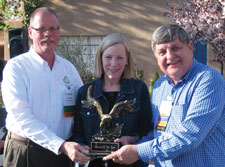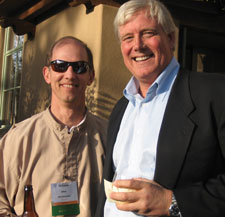SANTA FE, N.M.—“Outlets, outlets, outlets.” That has become the mantra of Frank Hurd, chairman of the Carpet America Recovery Effort (CARE) as the organization continues its quest to divert as much carpet as possible from landfills.
 The success of an organization like CARE is predicated as much on finding avenues in which to sell engineered resins as it is on finding ways to recover post-consumer carpet and recycle it cost-effectively. “We are working as an organization, and manufacturers are working on it,” Hurd said.
The success of an organization like CARE is predicated as much on finding avenues in which to sell engineered resins as it is on finding ways to recover post-consumer carpet and recycle it cost-effectively. “We are working as an organization, and manufacturers are working on it,” Hurd said.
At its annual conference here late last month, experts from every link in the chain divulged their challenges and opportunities in the world of landfill diversion and recycling of post-consumer carpet. There were carpet manufacturers, carpet collectors, carpet recyclers and processors, and end users. At the end of the day, two of the major issues are collectors needing to increase their profitability and the recyclers needing to find outlets in which to sell the processed materials.
“We have to have more end-use products to consume this material,” said Larry Cook, director of manufacturing, Beaulieu Group. “That will help drive this entire process. It has to be a pull process. We can’t build it and stack it somewhere.”
Hurd noted that anything that uses plastic is a potential outlet and added that much of the success going forward will lie with the processors. “As the raw materials coming in are cleaner, we as an industry have a better opportunity to use them. So I see gains coming from improved methodology on the processing.”
Rick Ramirez, vice president of sustainability and environmental affairs, Shaw Industries, believes the manufacturers must design products keeping in mind what happens to the materials at the end of their useful life. To that end, Shaw established a separate business unit to find end uses for post-consumer products beyond carpet and automotive.
Vann Brown, vice president of innovation and technology, believes if more industries like automotive would specify products with recycled content, it would have a “dynamic” effect on the carpet recycling industry.
Economics also plays an important role. “It’s all about finding ways to recycle post-consumer carpet cost effectively and compete against other materials, like post-industrial,” Hurd said. “That’s what we as an organization and the individual manufacturers are working on.”
Brown agreed. “We still have to compete with virgin materials. Everyone is going after nylon 6 and 6,6 because it’s cheaper than virgin material. But that is not the case on the PET side.”
Then there is the issue of collecting the carpet. There are currently 68 reclaimers throughout the country, some that are growing and some that have had to retrench. Hurd said all the major metropolitan areas are covered with strong collection networks. “They must be in areas where there is enough volume to support the collection network and enough customers to process the material. The big challenge, though, is setting up a network where we are not transporting the carpet 1,000 miles. So the key is regional collection and processing.”
John Votaw, owner of Southeastern Plastics Recovery in Charleston, S.C., told FCNews of the many challenges impacting business on the collection side, not the least of which are small margins. “As more people demand sustainability and recycling becomes more accepted, volumes of material will increase, and hopefully we will be able to increase our price for hauling it,” he said.
Some people believe that carpet collection is a free service, or that the mills pay for it. “I’ve spent the last few years telling people that this is a for-charge service,” Votaw said. “The carpet pad people and carpet reps are telling retailers we make all this money. We get paid by the pound, and we are talking cents. And given that retailers are having a hard time, we can’t enact a price increase on the hauling side.”
The economy has also had a negative impact on Southeastern Plastics Recovery. “I lost 30% of my retailers in the past two and a half years,” Votaw said.  “Not only that, there is a lot more hardwood being sold [in lieu of carpet].”
“Not only that, there is a lot more hardwood being sold [in lieu of carpet].”
But the biggest challenge, he said, are the collectors who come into your territory. “People come in, haul carpet to another state and sell it up there. Who knows where it came from?”
CARE’s record year
CARE is certainly doing its part. In 2009, members diverted a record 311 million-plus pounds of post-consumer carpet from landfills, up 6% from 2008, despite carpet industry sales falling 15%. Of that amount, 246 million pounds—nearly 80% of the total—was recycled back into carpet and other consumer products. “This occurred during one of the most dire economic environments the country has ever faced,” Hurd said. “Before the last two years, you had to go back to 1975 and 1976 to find two consecutive years of declining sales. “We are proud of the increases in both carpet diversion and recycling.”
So what’s driving these gains? According to Hurd, CARE made a decision about two or three years ago to start focusing on the plastics industry. “We came to the realization that if we could process the plastic and make an engineered resin out of it, we could get into the compound market.”
The next thing CARE did was raise awareness in the plastics industry that it had material available. Post-consumer carpet was not on their radar, Hurd said. “A lot of work was done to get involved with that community.” He noted that CARE is starting to see the automotive industry improve, so growth in demand for nylon 6 and nylon 6,6 is expected.
Increasing membership is also going to drive CARE going forward. Last year CARE embarked on something of a membership drive. The plan was to bring in more affiliated associations and others who could benefit from CARE membership. With that, the group now includes 111 Starnet members and 97 ReSource members, bringing the total to 287.
-Steve Feldman
